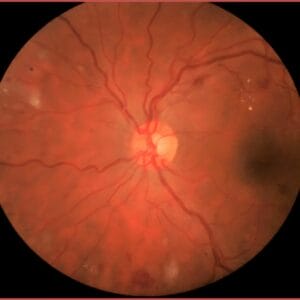April 11, 2023
Most nutrients act on hundreds of pathways and enzyme systems, whereas most prescription drugs act on just one pathway. In this way, nutrients function as a symphony, but deficiencies are still very common, especially among the aging population. These deficiencies drive oxidative stress and inflammaging. Three of the most common nutrient deficiencies in the aging population include vitamin D, magnesium, and omega-3 fatty acids.
Elderly Patients Have Higher Rates of Vitamin D Deficiency
In America, studies have shown that vitamin D deficiency is a driver of both systemic and ocular inflammation. There is a high prevalence of vitamin D deficiency worldwide, but it is particularly seen at a higher rate with elderly patients (85%).1 Vitamin D deficiency is lower in those with higher melanin counts (i.e. darker skin) due to the pigment’s interference with sun absorption. 2 Vitamin D deficiency is also common among those living in northern latitudes and patients who chronically use proton-pump inhibitors.
Vitamin D acts as an antioxidant, an immunomodulator, a regulator of angiogenesis and apoptosis, and directly or indirectly regulates up to 5% of the human genome or over 900 different genes.3 It is well established that oxidative stress, inflammation, and angiogenesis play a critical role in the development and progression of macular degeneration and other disorders of the aging retina such as diabetic retinopathy. Vitamin D deficiency plays a key role in all of these.
In a 2019 paper by Tohari et al., “Vitamin D Attenuates Oxidative Damage and Inflammation in Retinal Pigment Epithelial Cells,” the researchers examined the ability of vitamin D to protect RPE cells from oxidative stress and reduce inflammation. Cells were challenged with a strong oxidant, H2O2, and treated with vitamin D (versus control cells). Vitamin D was shown to suppress oxidative damage and inflammation in RPE cells. It significantly increased cell viability through antioxidant signaling pathways.4
In a 2021 review paper by Valle et al., vitamin D’s role in diabetic retinopathy was explored. The paper, “Protective role of vitamin D against oxidative stress in diabetic retinopathy,” looked at the molecular mechanisms by which vitamin D protects the eye from oxidative stress. The authors point out that in the last few decades, it has been reported that vitamin D is involved in the pathogenesis of diabetic retinopathy. The authors cite data showing that vitamin D modulates the production of advanced glycosylated end products (AGEs), as well as several pathways, including protein kinase C, the polygon pathway leading to the reduction of free radical formation. It also prevents the translocation of nuclear factor kappa B, preventing the inflammatory response, acting as an immunomodulator, and modulating autophagy and apoptosis.5
Foods that provide vitamin D include fatty fish, cheese, egg yolks, beef liver, and foods fortified with vitamin D such as some dairy products, orange juice, soy milk, and cereals. Many supplements for ocular health now contain vitamin D as well.
Magnesium Supplements Improve the Visual Field of Glaucoma Patients
Vitamin D cannot be metabolized without sufficient magnesium levels.6 Studies estimate that 75% of Americans do not meet the recommended dietary allowance of magnesium (Mg), with Mg deficiency being one of the most common nutrient deficiencies affecting an estimated 50%-80% of older adults.7 Several changes of magnesium metabolism have been reported with aging, including diminished Mg intake, impaired intestinal Mg absorption, and renal Mg wasting. Mg deficiency has been associated in preclinical, epidemiological, and clinical human studies with an increased production of free radicals and oxidative stress, low-grade systemic inflammation, and increased levels of inflammation markers and pro-inflammatory molecules.8 Mg is the second most common intracellular cation, and it is a major co-factor in over 300 reactions, being highly conserved within energy-dependent organelles such as the mitochondria.
In ocular tissues, Mg is present mainly in the cornea, lens, retina, and in the anterior chamber, with deficiencies being linked to antioxidant and ionic imbalances.9,10 Furthermore, significant magnesium deficiency has been identified in patients with glaucoma, with magnesium supplementation having been shown to improve the visual field of glaucoma patients.11
In a 2022 article in Frontiers in Ophthalmology, “Magnesium and its Role in Open Angle Glaucoma,” the authors show that magnesium deficiency is common in POAG and that supplementing with Mg improves mitochondrial dysfunction, inflammatory stress, intracellular calcium influx, vascular dysregulation, and vasoconstriction.12
Vascular health is central to healthy aging and retinal health. Magnesium’s role in vascular health is well established. Mg regulates cardiac excitability, neuromuscular conduction, muscular contraction, vasomotor tone, and blood pressure. Mg has been shown to lower blood pressure as much as 5.8/2.8mmHg.13 Mg has been shown to reduce post-op atrial fibrillation after cardiac surgery.14 Studies have shown that circulating and dietary Mg are inversely associated with cardiovascular disease risk, which underlies the health of retinal vasculature.15
There are many different forms of Mg. Magnesium Oxide is the most prescribed form but the least absorbable. Magnesium Glycinate (chelated) is the best bioavailable and absorbable. Typical dosages for supplementing are 250 mg. once or twice a day of Mg Glycinate. Foods high in Mg include dark chocolate, nuts, avocados, legumes, seeds, whole grains, bananas, leafy greens, some fatty fish, and whole grains.
Omega-3 Fatty Acids Are Beneficial to Retinal Health
Low intake of omega-3 fats ranked number two (behind low intake of nuts) as one of the most costly contributors to diet-related cardiometabolic disease in a recently published study. Study co-authors Thiago Veiga Jardim, MD, PhD, at the Harvard T.H. Chan School of Public Health and Dariush Mozaffarian, MD, DPh, MPH, with the Friedman School of Nutrition Science and Policy at Tufts University, concluded that “suboptimal diet of 10 dietary factors accounts for 18.2% of all ischemic heart disease, stroke and type 2 diabetes costs in the U.S., highlighting that timely implementation of diet policies could address these health and economic burdens.” (These are the 10 suboptimal dietary factors: high sodium, low nuts/seeds, high processed meats, low seafood/omega-3 fats, low vegetables, low fruits, high sugar-sweetened beverages, low whole grains, low PUFAs replacing carbohydrates or saturated fats, and high unprocessed red meats.)16
Omega-3 fats have long been known to exert anti-inflammatory effects mediated via enzyme and prostaglandin competition and more recently through nutrigenomic and resolvin effects. Omega-3 fats have been studied extensively in ocular health and have shown benefits in retinal physiology where DHA is embedded into cell membranes, brain health, dry eye disease, meibomian gland dysfunction, autoimmunity, etc.
The standard American diet is insufficient in the omega-3 fats EPA and DHA. In a study recently published, the authors examined data from NHANES 2017-201817 and found that American adults consumed approximately 35 mg per day of EPA and 76 mg per day of DHA. The American Heart Association recommends consuming oily fish at least twice per week, which equals approximately 500 mg of EPA plus DHA. In addition, individuals with documented cardiovascular disease should consume approximately 1 g per day of EPA plus DHA. The World Health Organization recommends consuming 0.25 to 2 g per day of EPA plus DHA. As such, American adults did not meet the recommendations for EPA and DHA.18
New data from the National Eye Institute’s 10-year, post hoc analysis of the AREDS and AREDS2 trials further supports the benefits of increasing omega-3 in the diet. The analysis showed that a diet high in fish can reduce the chances of developing late AMD by 65% in patients who also have protective genes and in the general AMD population, a high fish diet reduced progression of intermediated AMD, with bilateral large drusen, to geographic atrophy by 31%.19
As practitioners who routinely care for aging eyes, it is important to be well versed in basic patterns of eating and nutrition that promote health and well-being. Our patients need evidence-based recommendations on ways to add not only years to their lives but life to their years. Preserving good vision is our obligation to them.
References
1 Kweder, H., & Eidi, H. (2018). Vitamin D deficiency in elderly: Risk factors and drugs impact on vitamin D status. Avicenna journal of medicine, 8(4), 139–146.
2 Webb, A. R., Kazantzidis, A., Kift, R. C., Farrar, M. D., Wilkinson, J., & Rhodes, L. E. (2018). Colour Counts: Sunlight and Skin Type as Drivers of Vitamin D Deficiency at UK Latitudes. Nutrients, 10(4), 457. 3.
3 Wang, T-T, Tavera-Mendoza LE, Laperriere D, et al. Large-scale in silico and microarray-based identification of direct 1,25-hydroxyvitamin D3 target genes. Mol. Endocrinol. 2005;19:2685-2695.
4 Tohari, A. M., Alhasani, R. H., Biswas, L., Patnaik, S. R., Reilly, J., Zeng, Z., & Shu, X. (2019). Vitamin D Attenuates Oxidative Damage and Inflammation in Retinal Pigment Epithelial Cells. Antioxidants (Basel, Switzerland), 8(9), 341.
5 Valle MS, Russo C, Malaguarnera. (2021). Protective role of vitamin D against oxidative stress in diabetic retinopathy. Diabetes/Metabolism Research and Reviews/Volume 37, Issue 8.
6 Anne Marie Uwitonze, Mohammed S. Razzaque. Role of Magnesium in Vitamin D Activation and Function. The Journal of the American Osteopathic Association, 2018; 118 (3)
7 DiNicolantonio J, O’Keefe J, Wilson W. Subclinical magnesium deficiency: a principle driver of cardiovascular disease and a public health crisis. Open Heart 2018; 5(1).
8 Barbagallo M, Veronese N, Dominguez L. Magnesium in Aging, Health, and Diseases. Nutrients 2021Feb; 13(2):463.
9 Li X, Xie L, Pan F, Wang Y, Liu H, Tang Y, et al. A Feasibility Study of Using Biodegradable Magnesium Alloy in Glaucoma Drainage Device. Int J Ophthalmol (2018) 11(1):135–42. doi: 10.18240/ijo.2018.01.21
10 Pilchova I, Klacanova K, Tatarkova Z, Kaplan P, Racay P. The Involvement of Mg 2+ in Regulation of Cellular and Mitochondrial Functions. Oxid Med Cell Longev (2017) 2017:6797460. doi: 10.1155/2017/6797460,
11 Iomdina E, Arutyunyan L, Khorosheva E. Analyzing Trace Elements in the Structures of Glaucomatous Eyes. Int J Biomed (2019) 9(1):23–5.
12 Elghobashy M, Lamont H, Morelli-Batters A, et al. Magnesium and its role in primary open angle glaucoma; a novel therapeutic. Front. Ophthalmol. 09 June 2022 Sec. Glaucoma Volume 2-2022.
13 Houston, M. The role of magnesium in hypertension and cardiovascular disease. J Clin hypertens (Greenwich). 2011 nov; 13(11):843-7.
14 Fairley J et al. Magnesium status and magnesium therapy in cardiac surgery: A systematic review and meta-analysis focusing on arrhythmia prevention. J Crit Care. 2017 Dec;42:69-77.
15 Del Gobbo, LC et al. Circulation and dietary magnesium and risk of cardiovascular disease: a systematic review and meta-analysis of prospective studies. Am j Clin Nutr. 2013 jul;98(1):160-73.
16 Jardim TV, Mozaffarian D, Abrahams-Geisel S et al. Cardiometabolic disease costs associated with suboptimal diet in the United States: A cost analysis based on a microsimulation model. PLoS Medicine December 17, 2019.
17 The National Health and Nutrition Examination Survey (NHANES) is a program of studies designed to assess the health and nutritional status of adults and children in the United States. The survey is unique in that it combines interviews and physical examinations. NHANES is a major program of the National Center for Health Statistics (NCHS). NCHS is part of the Centers for Disease Control and Prevention (CDC) and has the responsibility for producing vital and health statistics for the Nation.
18 Froyen E, Maarafi Z. The consumption of omega-3 fatty acids in American adults. Current Developments in Nutrition, Volume 6, Issue Supplement_1, June 2022.
19 Argon E, Mares J, Swarovski A, Chew, E, Keenan D et al. Dietary nutrient intake and progression to late age- related macular degeneration in the age-related eye disease studies 1 and 2. Clinical Trial. Ophthalmology. 2021 Mar;128(3):425-442.





